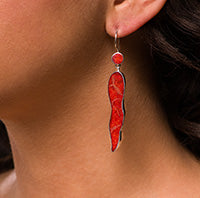Coral - a gift from the sea - Coral's qualities; How to buy coral; and How to care for coral


 Coral has an ocean energy. It was, in fact, first thought to be a plant and was later learned to be an invertebrate animal that belongs to a group called Cridaria. Other animals in the same group as coral are Jelly fish and sea anemones. Coral live in groups of hundreds or even thousands of genetically identical corals created from a coral larva.
Coral has an ocean energy. It was, in fact, first thought to be a plant and was later learned to be an invertebrate animal that belongs to a group called Cridaria. Other animals in the same group as coral are Jelly fish and sea anemones. Coral live in groups of hundreds or even thousands of genetically identical corals created from a coral larva.
There are two kinds of coral: hard or soft.
Soft corals do not have the “rock-like” consistency and often hang down from caves and ledges with feather tentacles that collect food from the water. They look like brightly colored plants which accounts for why they were originally thought of as a plant, whether soft or hard coral.
Hard corals come in around 800 different species and they form on reefs. They extract calcium from sea water and form a hardened structure to protect themselves. Coral reefs are essential for the ecosystem of the oceans. As a result, international laws exist to protect it from being harvested for use in jewelry and carvings, etc.
reefs. They extract calcium from sea water and form a hardened structure to protect themselves. Coral reefs are essential for the ecosystem of the oceans. As a result, international laws exist to protect it from being harvested for use in jewelry and carvings, etc.
What we use in jewelry making is hard coral from the “deep oceans” that is collected after it has died. Because coral is a living animal, what is made into jewelry is the “skeletons” of the animal.
Precious and semi-precious coral
The characteristics of coral used for jewelry are: color, porosity, hardness, and luster. Precious corals have more color, are not very porous, are harder, and they have a rich luster to them. Precious coral is expensive as it is rarer than semi-precious coral.
Semi-precious coral is easy and plentiful to get and is not as rich in color or as hard and is more porous. It has to be stabilized so that it won’t break and it often has holes in it as it is porous and the holes have to be filled. It is often dyed to obtain a deeper color.
Precious corals are:

Red coral is often from the Mediterranean Sea or from the Japan Seas. Also, pink, gold, black, bamboo are all considered precious corals.
Semi-precious corals are:
 Blue corals that range in color from grey to blue and are from coral reefs.
Blue corals that range in color from grey to blue and are from coral reefs.
Sponge corals (which are not sponges) that must be stabilized and dyed to look good. There are also: Apple Coral, Tiger Coral, and White Coral. Most all semi-precious corals are dyed and stabilized.
How to buy good quality coral that is legal in the US:
Imported coral in the US has already met the legal requirements, so you should be safe in buying it. If you are planning a trip abroad and think you might want to buy coral, check the Cite requirements (can be found online) for buying coral.
Inspect the look and feel of the coral to make sure that it is good quality. The highly prized precious coral will feel like a rock and be shiny without looking like it was coated or dyed in any way. The deeper the red color (unless dyed), the better quality. Dyed coral is often very uniform in color and will not have streaks or variations in color that undyed, natural coral has.
 Affordably priced coral jewelry is most often dyed and is semi-precious and is usually 100% legal. If you are looking to buy an expensive piece of coral jewelry, you can check to see if it is real by using a cotton swab dipped in lemon juice and swipe it on an inconspicuous place. If it bubbles, it is real coral.
Affordably priced coral jewelry is most often dyed and is semi-precious and is usually 100% legal. If you are looking to buy an expensive piece of coral jewelry, you can check to see if it is real by using a cotton swab dipped in lemon juice and swipe it on an inconspicuous place. If it bubbles, it is real coral.
To see if it is dyed, put acetone on a white cloth and rub an inconspicuous place. The dye will come off if it was dyed.
Care of coral jewelry:
Coral is softer than other gemstones, so avoid scratching it or hitting it against hard objects. . Wipe it down with a soft, damp cloth to clean it. Avoid putting it into hot water (washing dishes with a coral ring on). Keep it away from any chemicals. Put on your cosmetics and perfumes before you put on your coral jewelry.
Coral properties are:
This stone has been sought after for centuries as a protection stone. It helps to keep negative energy away and to bring out the beauty inside a person. It can help with transformation. Since most coral used in jewelry is from calcium, it can strengthen bones and cartilage. Deep sea coral used in jewelry grows very slowly and can help the wearer with longevity when worn.
 As a “gift from the sea” it can help a person gain balance and a harmony with nature.
As a “gift from the sea” it can help a person gain balance and a harmony with nature.
Https://finessejewelry.net Copy-write: Sandra Jeffs (2016)

 Coral has an ocean energy. It was, in fact, first thought to be a plant and was later learned to be an invertebrate animal that belongs to a group called Cridaria. Other animals in the same group as coral are Jelly fish and sea anemones. Coral live in groups of hundreds or even thousands of genetically identical corals created from a coral larva.
Coral has an ocean energy. It was, in fact, first thought to be a plant and was later learned to be an invertebrate animal that belongs to a group called Cridaria. Other animals in the same group as coral are Jelly fish and sea anemones. Coral live in groups of hundreds or even thousands of genetically identical corals created from a coral larva. reefs. They extract calcium from sea water and form a hardened structure to protect themselves. Coral reefs are essential for the ecosystem of the oceans. As a result, international laws exist to protect it from being harvested for use in jewelry and carvings, etc.
reefs. They extract calcium from sea water and form a hardened structure to protect themselves. Coral reefs are essential for the ecosystem of the oceans. As a result, international laws exist to protect it from being harvested for use in jewelry and carvings, etc. Blue corals that range in color from grey to blue and are from coral reefs.
Blue corals that range in color from grey to blue and are from coral reefs. Affordably priced coral jewelry is most often dyed and is semi-precious and is usually 100% legal. If you are looking to buy an expensive piece of coral jewelry, you can check to see if it is real by using a cotton swab dipped in lemon juice and swipe it on an inconspicuous place. If it bubbles, it is real coral.
Affordably priced coral jewelry is most often dyed and is semi-precious and is usually 100% legal. If you are looking to buy an expensive piece of coral jewelry, you can check to see if it is real by using a cotton swab dipped in lemon juice and swipe it on an inconspicuous place. If it bubbles, it is real coral. As a “gift from the sea” it can help a person gain balance and a harmony with nature.
As a “gift from the sea” it can help a person gain balance and a harmony with nature.
Leave a comment